22 Nature-Inspired Wabi Sabi Kitchen Designs
The wabi-sabi kitchen embraces imperfection, simplicity, and the beauty of natural materials, creating a space that feels organic, serene, and deeply connected to the rhythms of daily life. Rooted in Japanese philosophy, wabi-sabi design celebrates the charm of weathered textures, handmade craftsmanship, and the quiet elegance of asymmetry. Unlike sleek, modern kitchens, a wabi-sabi space values authenticity over polish—where rough-hewn wood, exposed brick, and handmade pottery tell a story of time and use.
In this article, we explore 22 wabi-sabi kitchen designs that embody this mindful approach to living. From rustic wood and plastered walls to reclaimed materials and diffused natural light, each design showcases how imperfection can become artistry. Whether you’re drawn to minimalist simplicity, earthy textures, or the warmth of aged patinas, these kitchens demonstrate how to cultivate a space that feels both grounding and deeply personal.
1. Rustic Wood and Brick Wabi Sabi Kitchen
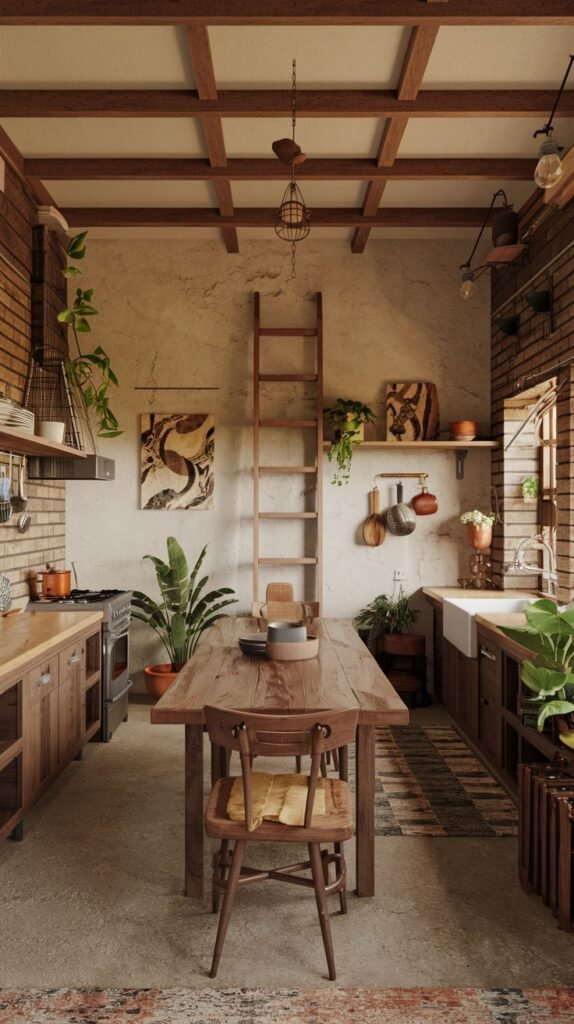
Embrace the raw beauty of natural materials by featuring exposed brick walls and substantial wooden beams in your wabi sabi kitchen. Install simple wooden cabinetry with visible grain and allow for open shelving to display your everyday dishes. Incorporate a large wooden dining table as the central gathering point. Lean a wooden ladder against a wall for functional and decorative storage, celebrating the imperfect nature of utilitarian objects.
2. Patinaed Simplicity Wabi Sabi Kitchen
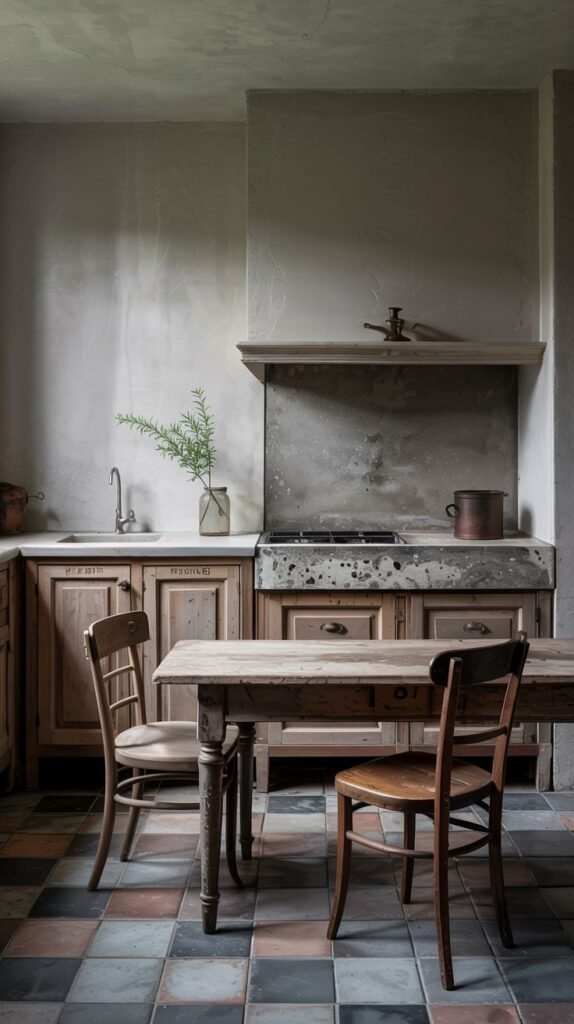
Focus on the beauty of age and wear by incorporating surfaces with a natural patina in your wabi sabi kitchen. Opt for simple, unadorned wooden furniture that shows its history. Choose a tiled floor with variations in color and texture, highlighting the beauty of natural materials. Keep decor minimal, allowing the inherent character of the materials to shine through.
3. Natural Wood and Diffused Light Wabi Sabi Kitchen
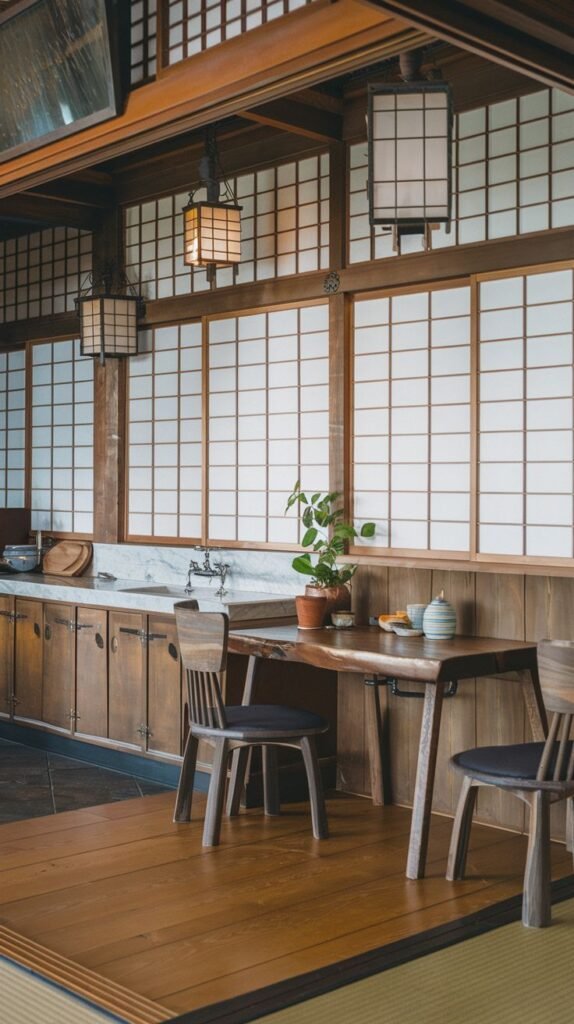
Create a serene atmosphere by emphasizing natural wood textures and soft, diffused light. Install wooden cabinetry with a natural finish and consider incorporating shoji screens or similar translucent panels to filter sunlight gently. Choose a low wooden table with simple chairs, promoting a sense of groundedness. Keep ornamentation to a minimum, focusing on the inherent beauty of the space.
4. Outdoor-Indoor Harmony Wabi Sabi Kitchen
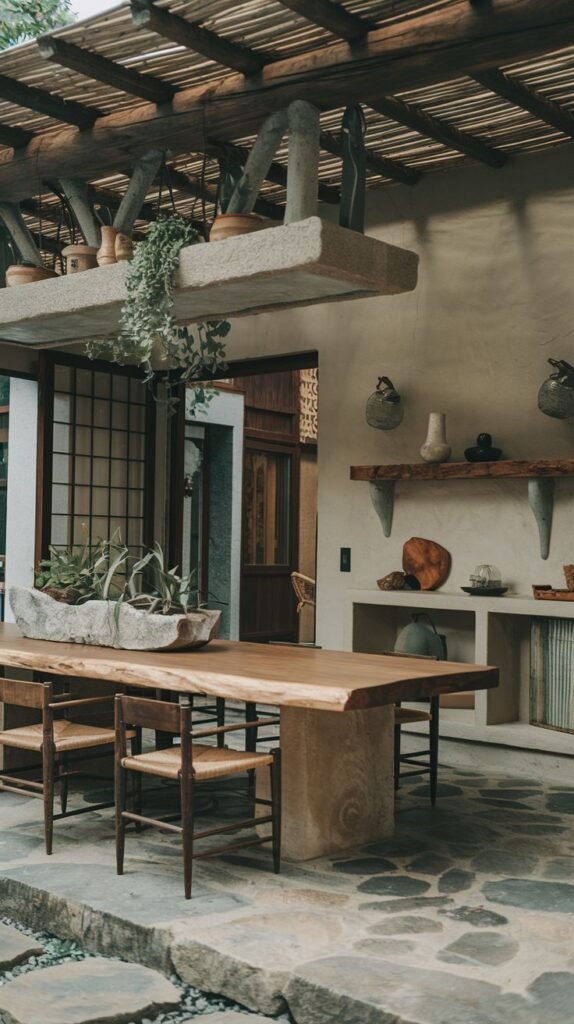
Blur the lines between indoors and outdoors by using raw stone and unfinished wood in your wabi sabi kitchen. Design for ample natural light and consider incorporating large openings to connect with the surrounding environment. Utilize open shelving made from rough-hewn wood or stone. Display pottery and natural objects with organic shapes, celebrating the beauty of the earth.
5. Earthy Textures and Functional Pottery Wabi Sabi Kitchen

Ground your space with earthy textures like a stone floor and simple plastered walls. Feature exposed wooden beams to highlight the structural elements. Install a rustic, functional stove as a focal point. Display handcrafted pottery and utensils on simple wooden shelves, emphasizing their practical beauty.
6. Arched Light and Minimalist Wood Wabi Sabi Kitchen
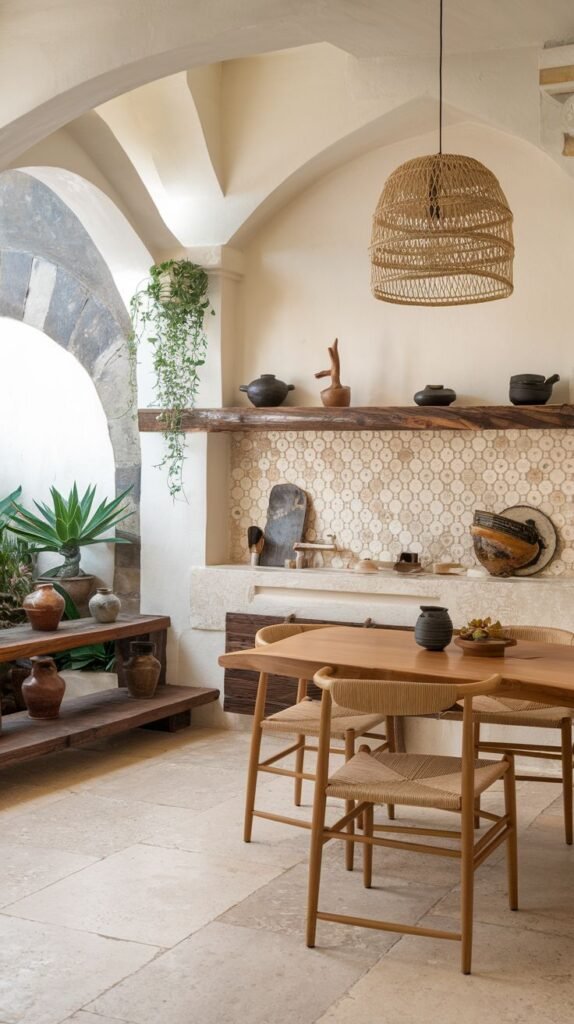
Introduce architectural interest with an arched doorway or window to flood your wabi sabi kitchen with natural light. Choose a simple wooden dining table paired with unassuming chairs. Maintain a minimalist approach to decor, allowing the clean lines and natural materials to define the space. Incorporate earthen pottery as subtle decorative accents.
7. Reclaimed Wood and Uneven Surfaces Wabi Sabi Kitchen
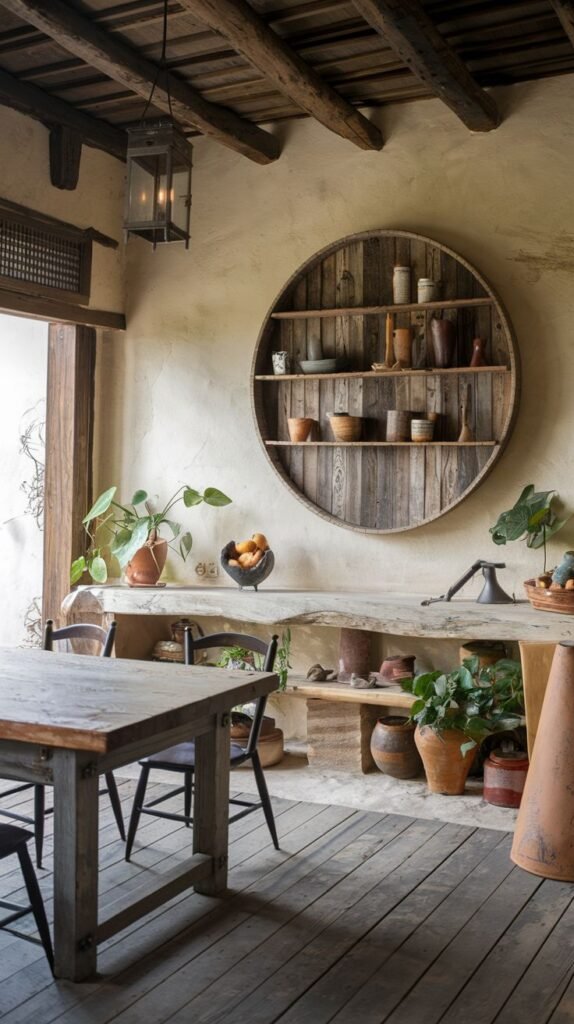
Celebrate the beauty of imperfection by incorporating reclaimed wood with visible wear and tear throughout your wabi sabi kitchen. Opt for rustic shelving with uneven surfaces and embrace the character of aged materials. Display a mix of old and functional items, highlighting their history. Introduce living plants to bring a touch of nature and vibrancy to the space.
8. Simple Forms and Earthen Walls Wabi Sabi Kitchen
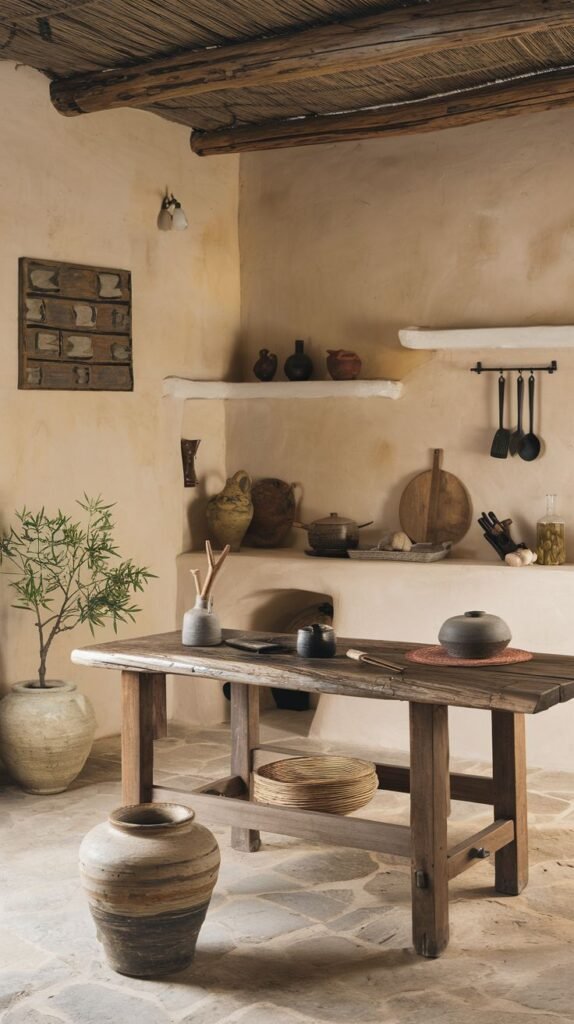
Embrace the essence of wabi sabi with simple, unadorned forms and earthen walls. Feature a basic wooden table as the central element. Keep the display of utensils and tools to a minimum, focusing on essential items with natural materials. Allow the subtle variations in the wall texture to add depth and character.
9. Wood-Dominated and Live-Edge Wabi Sabi Kitchen
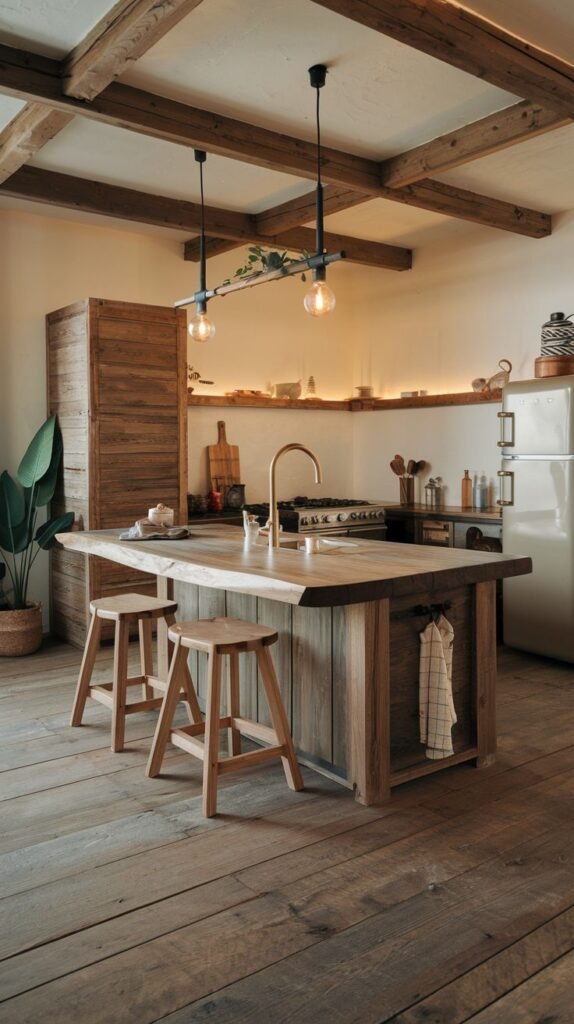
Immerse yourself in the warmth of wood by creating a wood-dominated wabi sabi kitchen. Feature a kitchen island with a live-edge wooden countertop, celebrating the natural form of the wood. Pair it with simple wooden stools. Emphasize the natural grain and texture of the wood throughout the space.
10. Adobe-Inspired and Handcrafted Wabi Sabi Kitchen
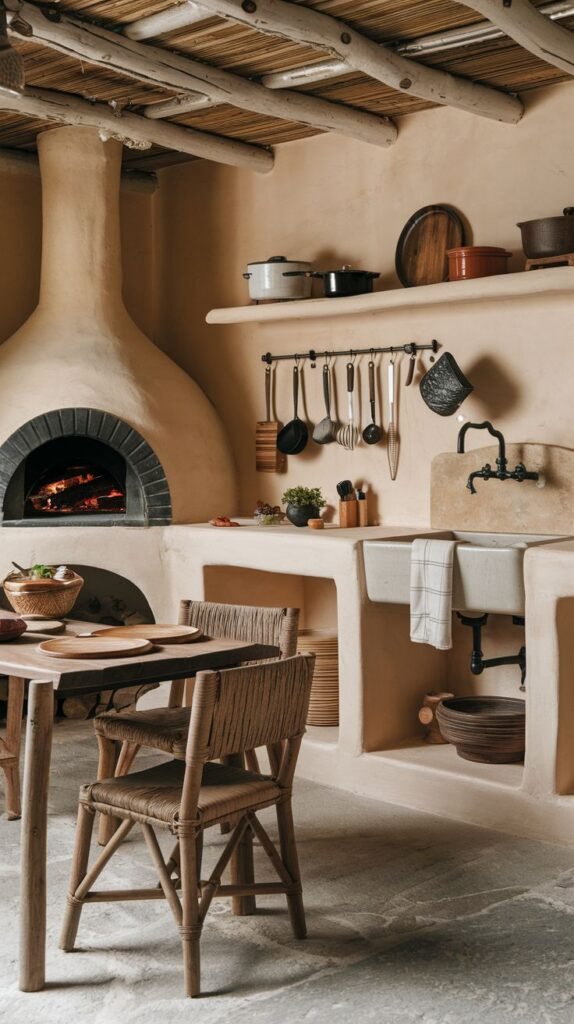
Draw inspiration from natural building techniques with an adobe-like aesthetic in your wabi sabi kitchen. Incorporate a simple wooden table and handmade pottery. Feature an open fire oven or hearth as a rustic focal point. Focus on the honesty and simplicity of natural materials.
11. Textured Wood and Plastered Walls Wabi Sabi Kitchen
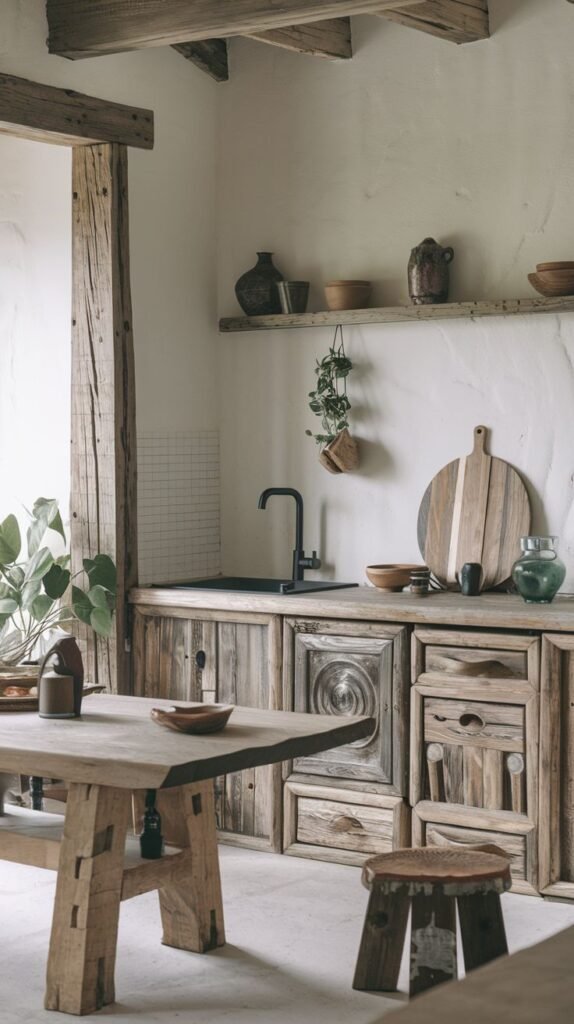
Create a tactile experience with heavily textured wooden cabinets and uneven plastered walls in your wabi sabi kitchen. Choose a simple, sturdy wooden table. Allow the rawness of the materials to be the primary decorative element. Keep accessories minimal and functional.
12. Light Wood and Natural Fiber Wabi Sabi Kitchen
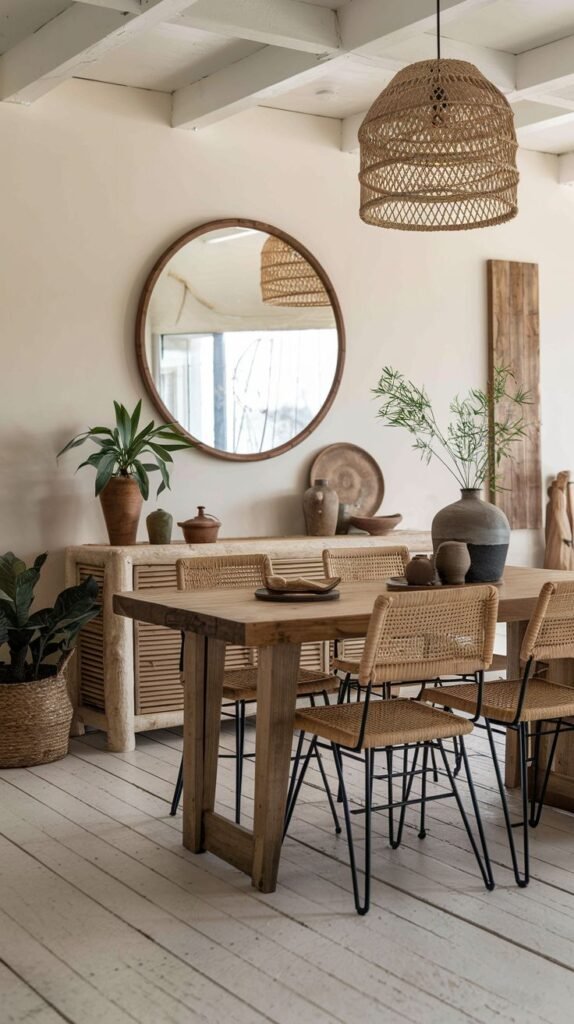
Cultivate a bright and airy feel with light-toned wood and natural fiber accents in your wabi sabi kitchen. Opt for simple wooden furniture and chairs with woven natural fiber seats. Keep decorative elements minimal, focusing on the subtle textures and natural light.
13. Exposed Brick and Rough-Hewn Wood Wabi Sabi Kitchen
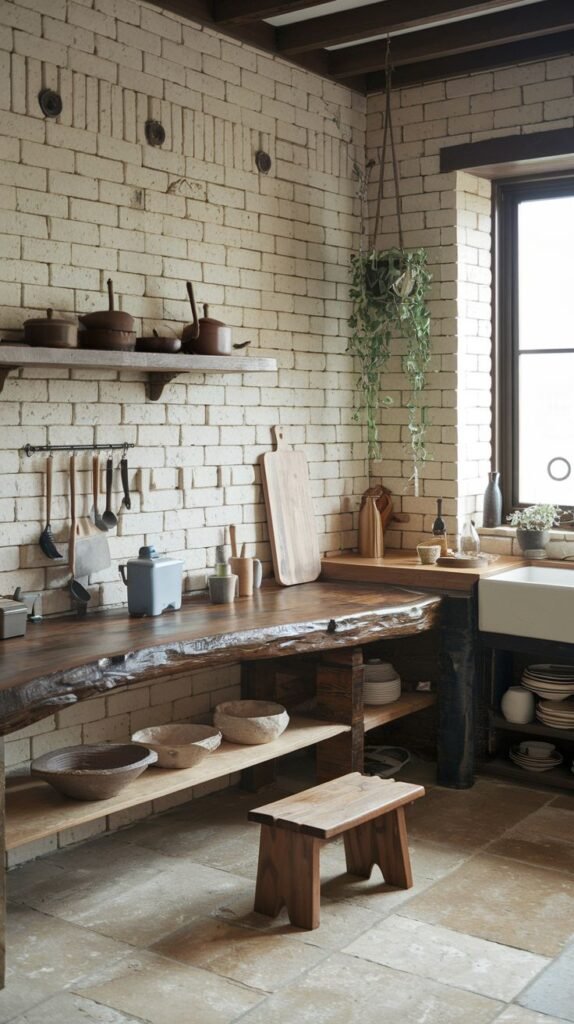
Highlight the structural integrity of your space with exposed brick walls and a rough-hewn wooden countertop. Install simple wooden shelving to display your essentials. Embrace a functional and unadorned aesthetic, celebrating the inherent beauty of the raw materials.
14. Old-World Charm and Functional Beauty Wabi Sabi Kitchen

Evoke a sense of timelessness with an old-fashioned stove as the centerpiece of your wabi sabi kitchen. Choose simple wooden furniture that complements the rustic feel. Maximize natural light to enhance the textures and subtle imperfections. Focus on functionality and the beauty of aged objects.
15. Earthy Tones and Natural Rugs Wabi Sabi Kitchen
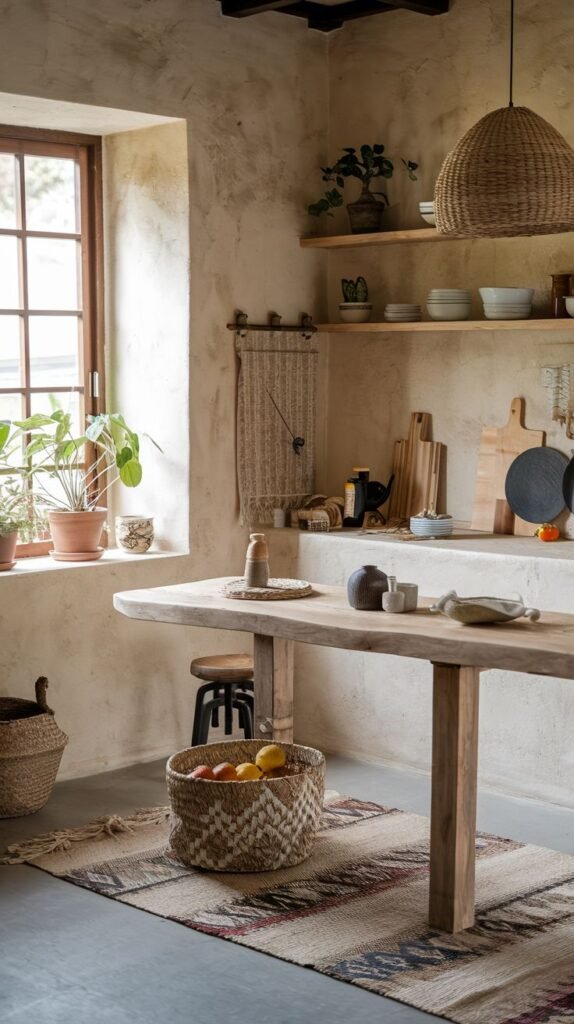
Create a warm and inviting atmosphere with earthy tones and a natural fiber rug in your wabi sabi kitchen. Feature a simple wooden table as the central gathering point. Keep ornamentation to a minimum, allowing the natural textures and subtle colors to create a sense of calm.
16. Wood and Stone Foundation Wabi Sabi Kitchen
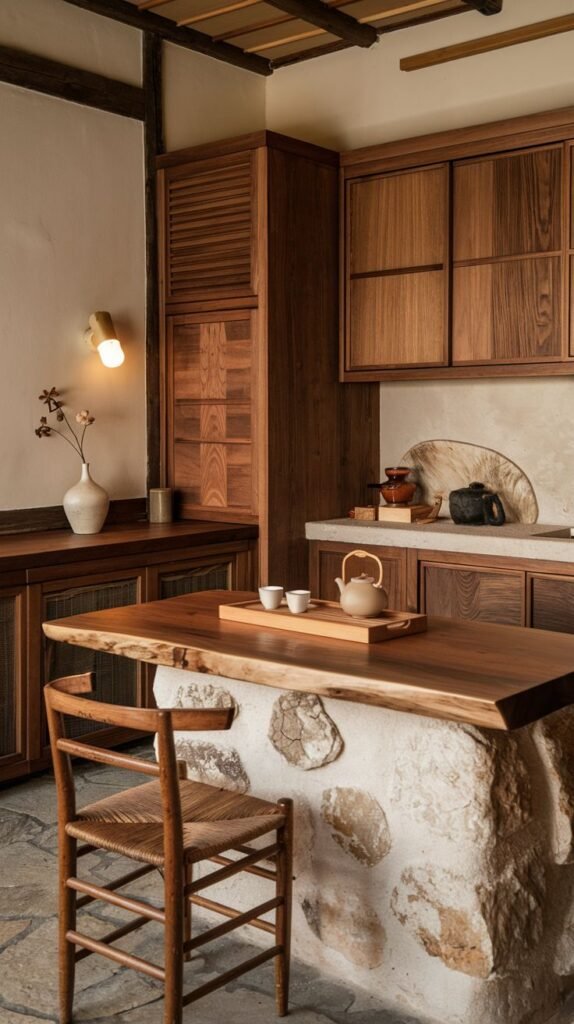
Ground your space with a combination of wood and stone elements. Consider a kitchen island with a stone base and a wooden countertop. Pair it with a simple wooden chair. Emphasize the contrasting textures and natural beauty of these materials.
17. Exposed Beams and Mismatched Simplicity Wabi Sabi Kitchen
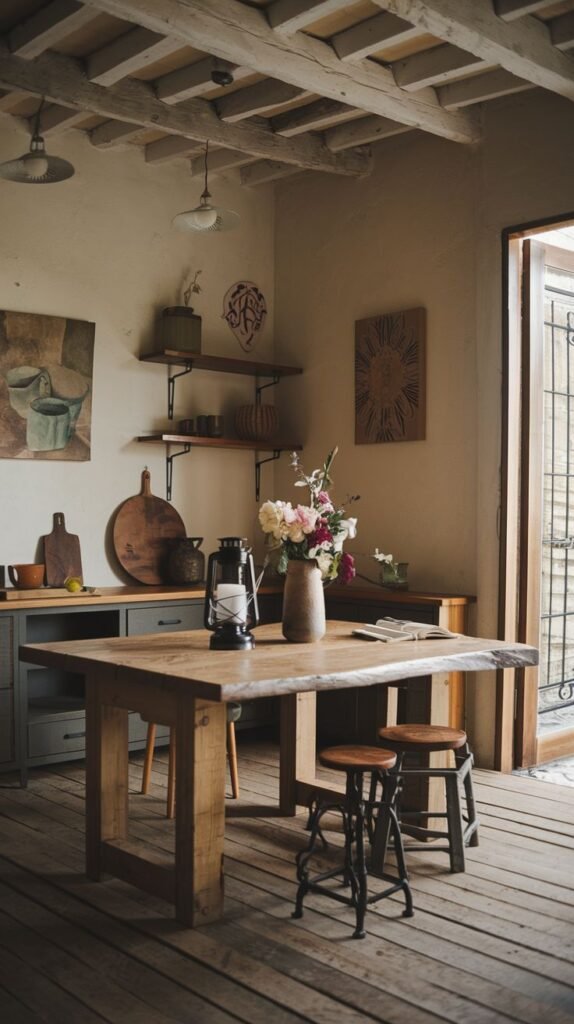
Highlight the architectural bones of your space with exposed ceiling beams in your wabi sabi kitchen. Choose a simple wooden table and embrace the charm of mismatched chairs. Display functional items as decor, celebrating their utilitarian beauty. Allow natural light to illuminate the textures and imperfections.
18. Indoor-Outdoor Flow and Natural Pottery Wabi Sabi Kitchen
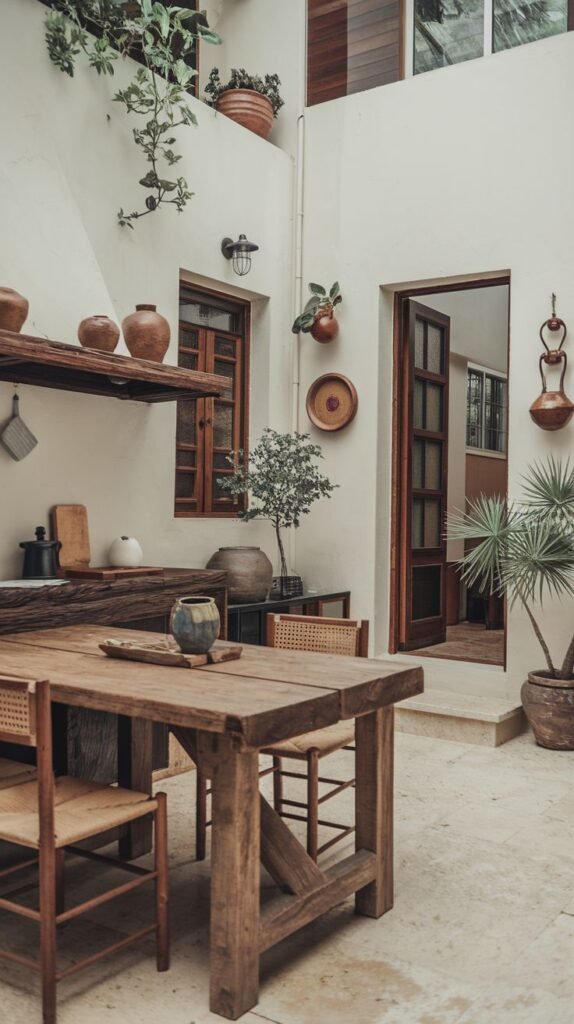
Extend your living space by creating a seamless indoor-outdoor flow in your wabi sabi kitchen. Incorporate simple wooden furniture and display natural pottery to connect with the earth. Maximize natural light and views of the outdoors, blurring the boundaries between inside and out.
19. Rustic Wood and Handcrafted Details Wabi Sabi Kitchen
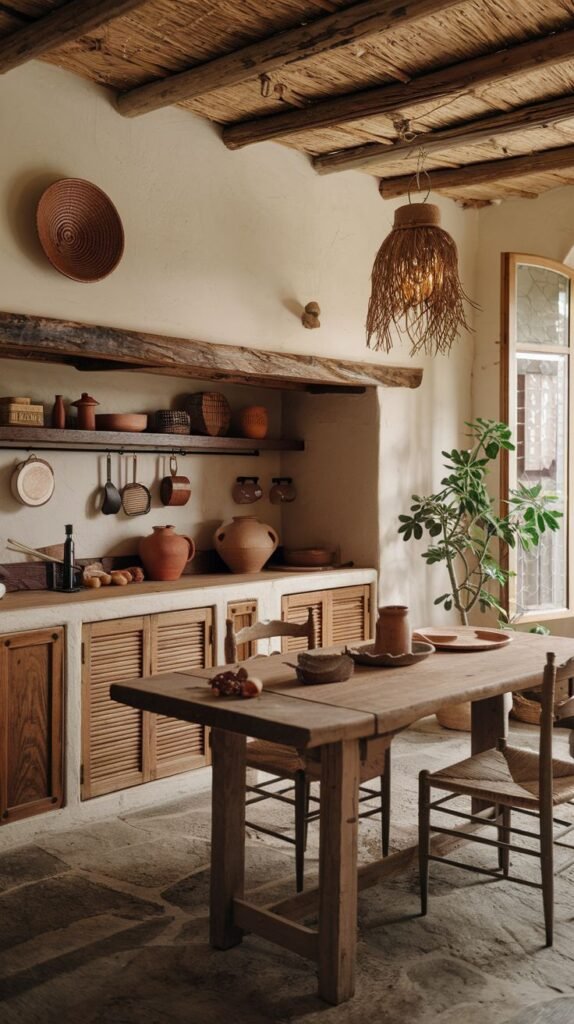
Embrace the charm of handcrafted elements with rustic wooden cabinets featuring visible joinery and imperfections in your wabi sabi kitchen. Choose a simple wooden table and incorporate natural fiber accents. Celebrate the unique character and warmth of handmade objects.
20. Wooden Sanctuary and Shoji Accents Wabi Sabi Kitchen
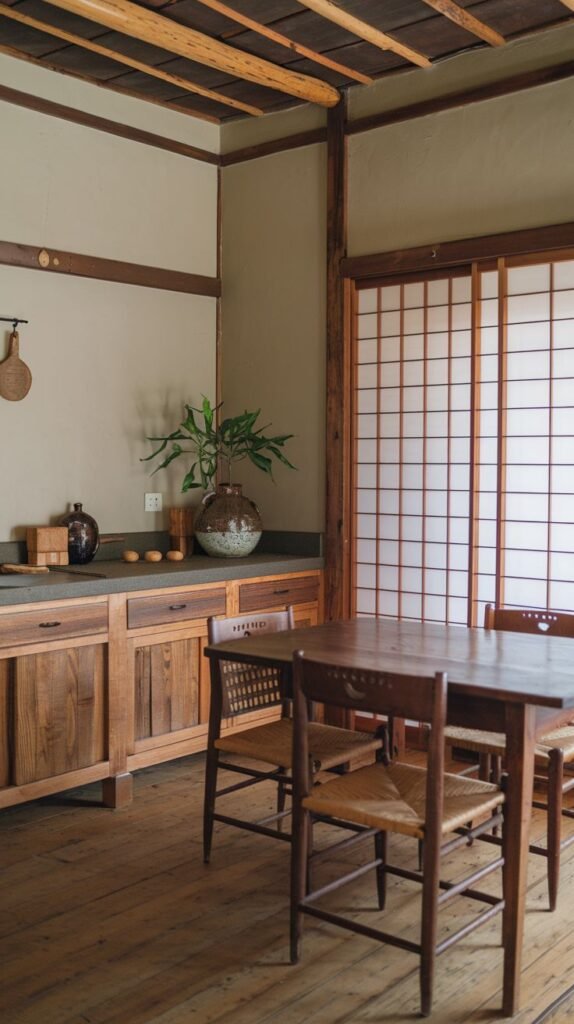
Create a tranquil sanctuary with wooden flooring, cabinetry, and furniture in your wabi sabi kitchen. Incorporate shoji screens or sliding doors to subtly diffuse light and create a sense of calm. Maintain a simple and functional design, focusing on the inherent beauty of the natural wood.
21. Raw Wood Textures and Minimal Structure Wabi Sabi Kitchen
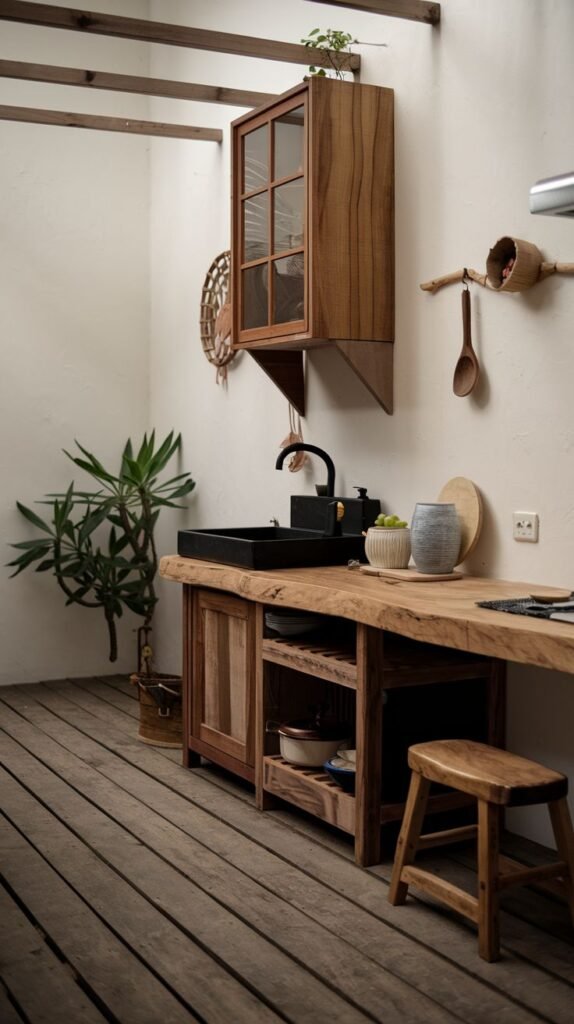
Focus on the unadulterated beauty of wood by featuring exposed wood structural elements and a countertop with a raw finish. Pair it with a simple wooden stool. Keep ornamentation to an absolute minimum, allowing the textures and natural variations of the wood to take center stage.
22. Plastered Curves and Natural Light Wabi Sabi Kitchen
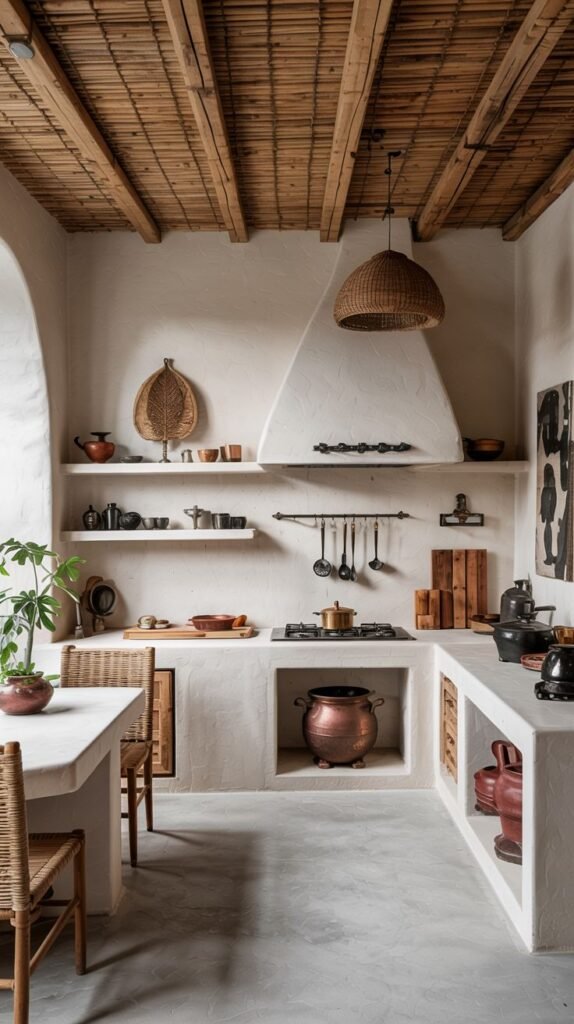
Soften the lines of your kitchen with plastered walls featuring gentle curves and an abundance of natural light. Choose a simple wooden table and chairs with natural fiber seating. Keep decor minimal, allowing the organic forms and natural materials to create a serene and imperfectly beautiful wabi sabi kitchen.
Conclusion
A wabi-sabi kitchen is more than a design choice—it’s a reflection of a philosophy that finds beauty in the imperfect, the transient, and the humble. The 22 kitchens featured here illustrate how raw materials, organic textures, and unrefined finishes can create spaces that feel alive with character and warmth. From exposed beams and rough-hewn wood to handmade pottery and plastered walls, each element honors the natural aging process and the quiet grace of simplicity.
By embracing asymmetry, natural light, and functional craftsmanship, these designs show that a kitchen doesn’t need to be flawless to feel harmonious. Instead, it thrives on authenticity, where every scratch, knot, and irregularity adds to its story. Whether you’re renovating or simply seeking inspiration, these wabi-sabi kitchens invite you to slow down, appreciate the imperfect, and create a space that nurtures both nourishment and mindfulness.
Let these ideas guide you toward a kitchen that feels not just lived-in, but deeply loved—a true sanctuary of quiet beauty.
